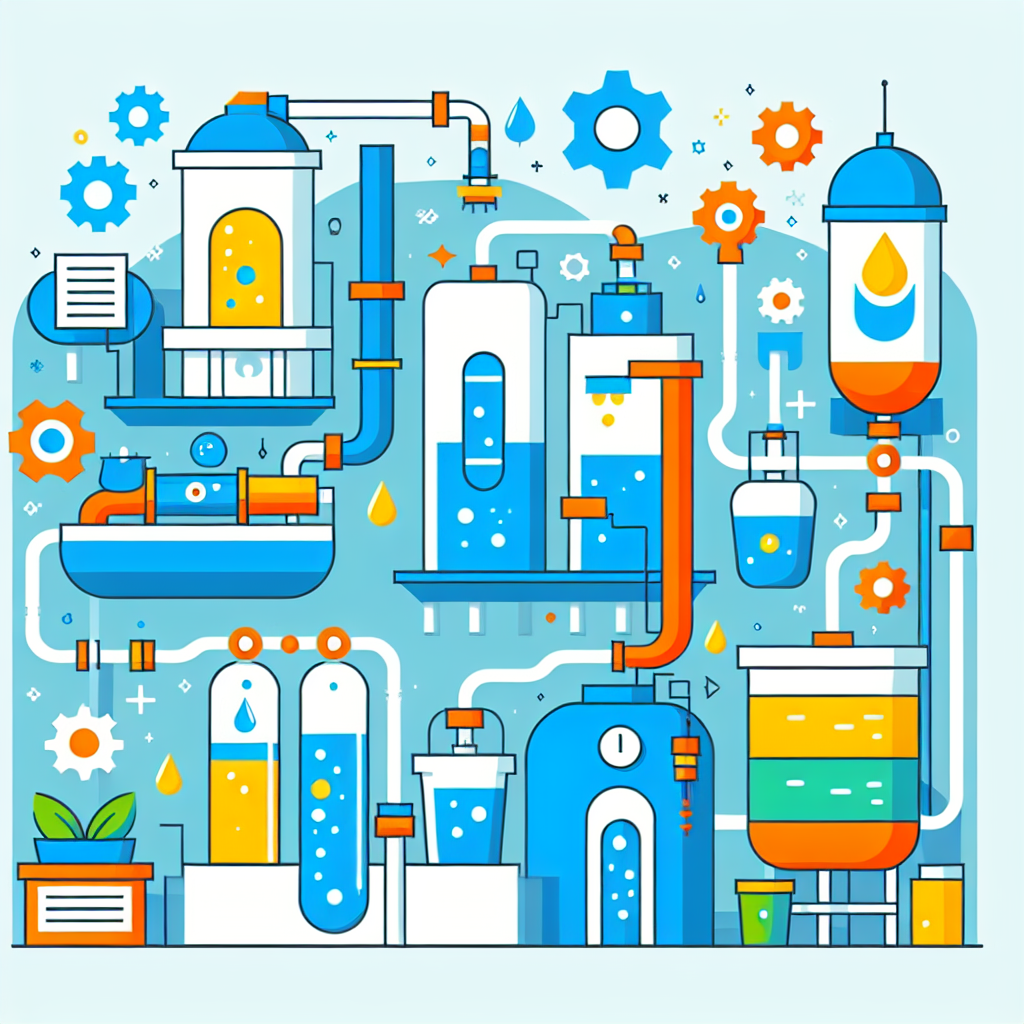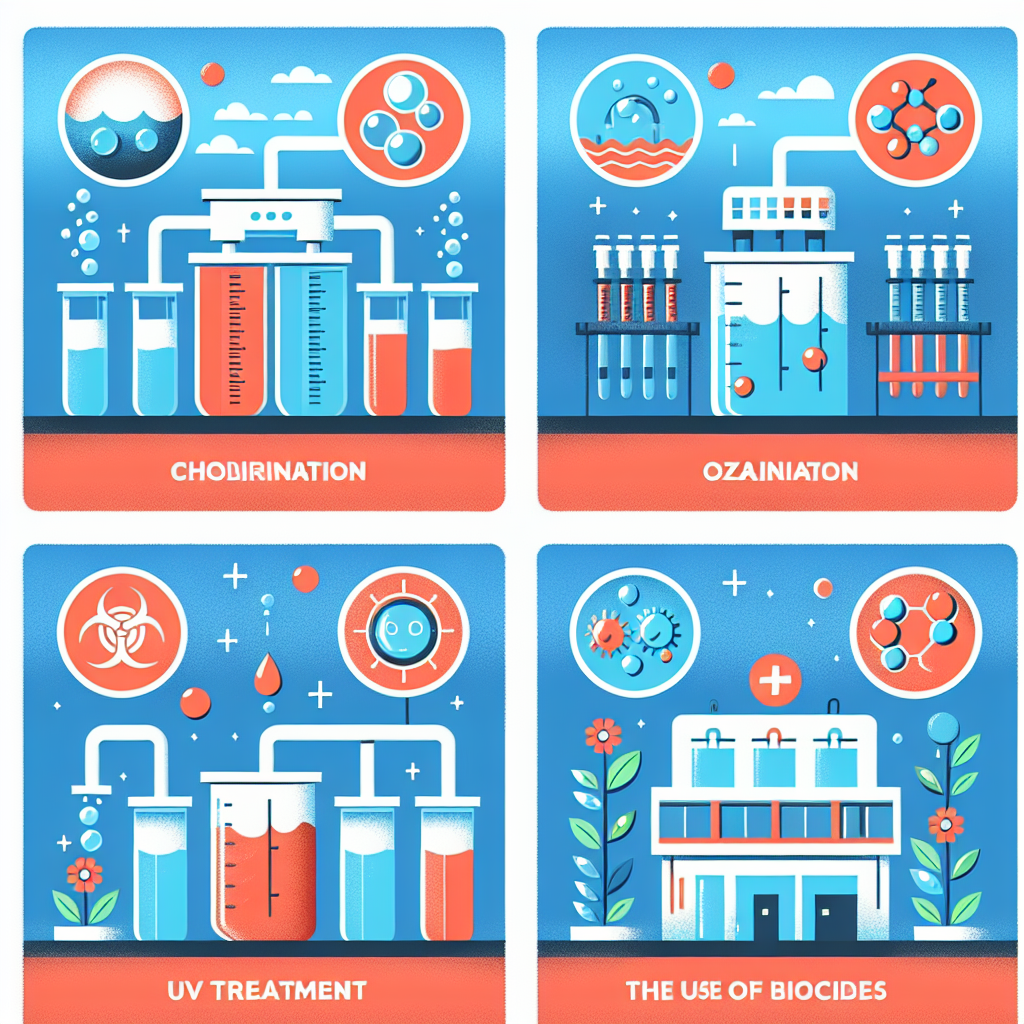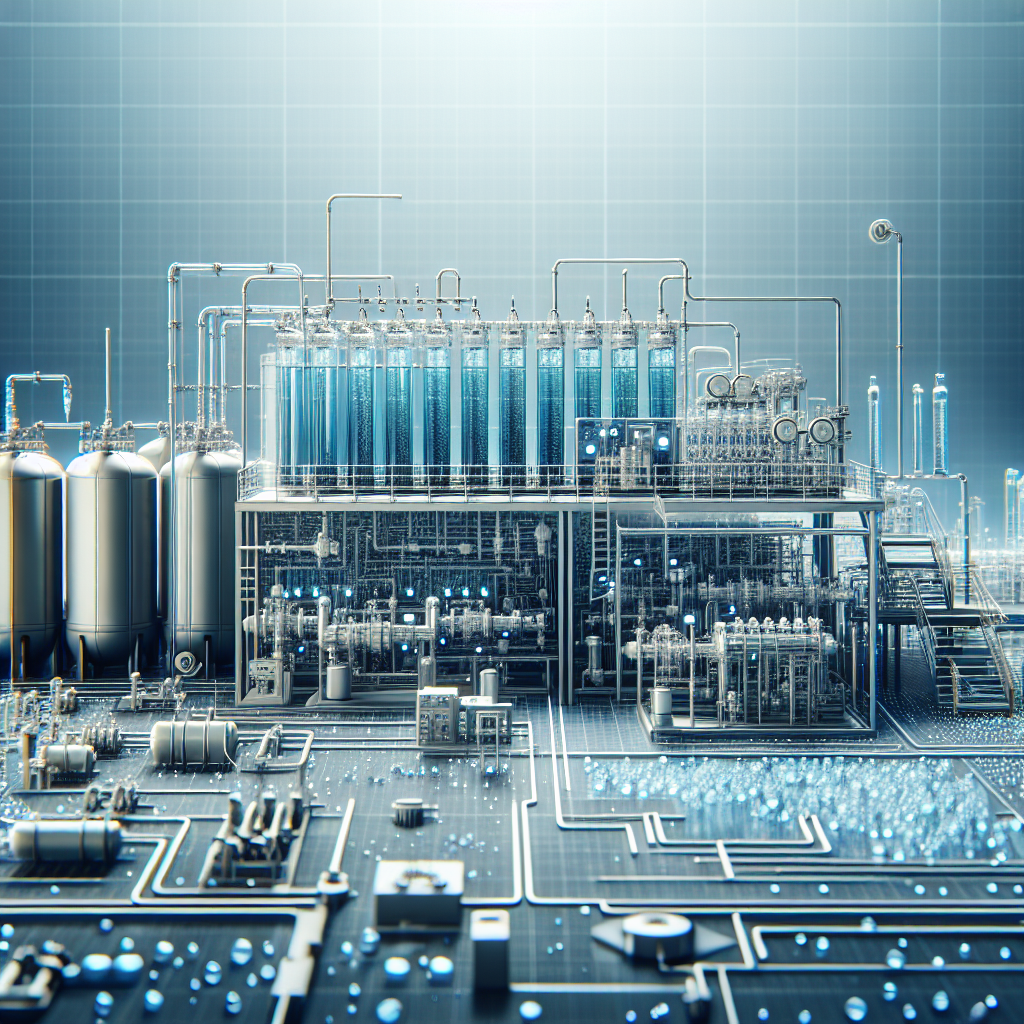Essential Chemical Processes in Modern Water Treatment

Essential Chemical Processes in Modern Water Treatment
Introduction
Welcome to the fascinating world of water treatment chemistry, where science meets necessity in the quest for clean and safe water! Whether you’re sipping on a refreshing glass of H2O or marveling at the intricacies of large-scale industrial water treatment, understanding the chemical processes behind it is crucial.
In today’s rapidly evolving landscape, effective water purification processes are more important than ever. With escalating concerns over contaminants, including heavy metals and pathogens, municipalities and industries alike are turning to advanced chemical water treatment solutions. But what does this all mean? Let’s dive into some key elements!
Think of water treatment chemistry like a superhero team-up: each process plays a unique role in battling impurities and ensuring that our water is not just drinkable but also meets stringent safety standards. From the mighty forces of coagulation and flocculation to the vigilant watch of disinfection methods like chlorination and ozonation, every chemical has its purpose.
The stakes are high; according to the EPA, lead contamination in drinking water remains a significant concern across many U.S. cities. This emphasizes why understanding these processes is not just academic it’s essential for public health and environmental compliance.
This blog post will explore various facets of water treatment chemistry, from basic concepts to advanced techniques that ensure our water systems remain resilient against contamination threats. So, grab your lab coats (or just a comfy chair), and let’s embark on this enlightening journey through modern water treatment!
Understanding Water Treatment Chemistry
Water treatment chemistry is like the secret sauce that transforms murky water into crystal-clear H2O. It involves a series of chemical processes designed to remove impurities, pathogens, and pollutants from water, making it safe for consumption and use. Think of it as a high-stakes chemistry experiment where the stakes are nothing less than public health and environmental safety!
In modern water treatment systems, the importance of this chemistry cannot be overstated. With growing populations and increasing industrial demands, municipalities are turning to sophisticated chemical water treatment methods to ensure that our most precious resource remains clean and accessible.
The Magic Behind Water Purification Processes
At its core, water treatment chemistry encompasses various water purification processes, including:
- Chemical Dosing: This involves adding chemicals to the water to facilitate reactions that remove impurities.
- Coagulation and Flocculation: These processes help in clumping together small particles so they can be easily removed.
- Disinfection: Techniques like chlorination or ozonation kill harmful microorganisms.
- Filtration: Advanced methods such as membrane filtration or activated carbon filtration help in further purifying water.
The Role of Chemistry in Industrial Water Treatment
Industrial facilities often generate large quantities of wastewater that need careful management. Here’s where specialized chemicals come into play. For instance:
- Corrosion Inhibitors: These protect pipes from rusting and extend their lifespan.
- Nutrient Removal Chemicals: Essential for reducing biological oxygen demand (BOD) and chemical oxygen demand (COD) in wastewater treatment plants.
- Sustainable Strategies: Utilizing advanced oxidation processes can significantly improve effluent quality while complying with environmental regulations.
Did You Know?
The global market for wastewater treatment chemicals is projected to reach billion by 2025! This growth highlights the increasing reliance on effective water treatment chemistry in both municipal and industrial sectors.
A Closer Look at Key Chemical Components
Diving deeper into the realm of water treatment chemistry reveals a variety of substances used in different processes:
- Polymeric Coagulants: These enhance the coagulation process by effectively binding particles together.
- Biocides: Used extensively in cooling tower applications to control microbial growth.
- Scale Inhibitors: Essential for preventing mineral buildup in reverse osmosis systems and boilers.
The Future of Water Treatment Chemistry
The landscape of water treatment is evolving with innovations like ion exchange resins for enhanced purification and advanced membrane technologies. As we face challenges like climate change and pollution, these advancements will be crucial for sustainable management strategies. The future looks bright if we continue leveraging the power of chemistry!
Key Water Purification Processes
When it comes to water treatment chemistry, understanding the key water purification processes is like knowing the secret recipe to a delicious dish. Each ingredient plays a crucial role in ensuring that the end product is safe and clean. Let’s dive into the main processes that make this happen!
Chemical Water Treatment Methods
Chemical water treatment methods are akin to a superhero team, each member specializing in a specific task to combat water impurities. Here are some of the heavy hitters:
- Coagulation: This process involves adding chemicals (coagulants) that bind with impurities, forming larger particles called flocs.
- Flocculation: After coagulation, gentle stirring helps these flocs clump together, making them easier to remove.
- Disinfection: Utilizing methods like chlorination and ozonation, this step kills pathogens and ensures safe drinking water.
- pH Adjustment: Maintaining the right pH is essential for optimal chemical reactions and effectiveness of other treatments.
Industrial Water Treatment Applications
The industrial sector employs these purification processes on a grand scale. Think of it as a massive concert where every instrument must be in harmony for the show to go on. Here are some applications:
- Pulp and Paper Industry: Uses chemical treatments to remove lignin and other impurities from wood fibers.
- Food and Beverage Production: Ensures that water used is free from contaminants that could spoil products or harm consumers.
- Pretreatment for Reverse Osmosis Systems: Essential for avoiding membrane fouling by removing suspended solids and colloids.
- Cooling Towers: Employs corrosion inhibitors and biocides to maintain system efficiency while preventing scale buildup.
Did you know? Effective chemical dosing systems can significantly enhance treatment efficacy by ensuring precise amounts of chemicals are used at all times!
The beauty of these processes lies in their synergy; together they create a robust framework for effective water treatment chemistry. As we move forward in this blog post, we’ll explore each process in detail to uncover how they contribute to cleaner, safer water for everyone!
Coagulation and Flocculation in Water Treatment
When it comes to water treatment chemistry, coagulation and flocculation are like the dynamic duo of the water purification world. Think of them as the Batman and Robin of getting rid of those pesky particles that make our water less than crystal clear.
The Coagulation Process Explained
Coagulation is the first step in this superhero saga. It involves adding chemicals, often referred to as coagulants, to the water. These coagulants, such as aluminum sulfate or ferric chloride, work their magic by neutralizing the charges on suspended particles. When these charges are neutralized, particles that were once repelling each other start to clump together a process known as aggregation.
Did you know? The coagulation process can significantly reduce turbidity levels in water by up to 90%!
The Role of Flocculation in Water Purification
Once coagulation has done its job, it’s time for flocculation to step in and take things up a notch. This is where the magic happens! During flocculation, gentle mixing helps to form larger aggregates called flocs from the smaller clumps created during coagulation. Imagine a dance party where tiny particles are holding hands and forming bigger groups that’s flocculation!
The larger these flocs become, the easier they are to remove from the water through sedimentation or filtration. This process enhances overall efficiency in chemical water treatment systems, ensuring your drinking water is not only clean but also safe.
Polymeric Coagulants in Wastewater Management
In recent years, there has been a shift towards using polymeric coagulants in wastewater management. These advanced chemicals offer several advantages over traditional coagulants:
- Enhanced Performance: They can effectively remove a wider range of contaminants.
- Lower Dosage Requirements: You need less polymer compared to traditional coagulants for similar results.
- Sustainability: Many polymeric coagulants are derived from renewable resources.
This means not only do they get the job done better, but they can also help reduce operational costs and environmental impact a win-win for both operators and Mother Earth!
In summary, mastering coagulation and flocculation processes is crucial for effective water treatment chemistry. By understanding how these steps work together, municipalities and engineers can ensure cleaner water for everyone while also navigating complex wastewater treatment challenges with ease.
Takeaway: Don’t underestimate the power of proper coagulation and flocculation; they’re essential for achieving high-quality effluent in modern wastewater treatment plants!
Disinfection Techniques in Water Treatment
When it comes to water treatment chemistry, disinfection is the superhero of the process, swooping in to save the day by eliminating harmful pathogens. Think of it as the bouncer at an exclusive club, ensuring only the good guys get in. Let’s dive into some popular disinfection techniques that are essential for effective water purification processes.
Chlorination in Water Treatment
Chlorination has been a go-to method for disinfection since the early 20th century. It involves adding chlorine or chlorine compounds to water, which react with contaminants and kill off pesky microorganisms. Not only does this process significantly reduce the risk of waterborne diseases, but it also helps maintain a residual disinfectant level throughout the distribution system. However, it’s important to balance chlorine levels because too much can lead to harmful byproducts.
Ozonation for Water Purification
If chlorination is the classic rock of disinfection methods, ozonation is like that cutting-edge indie band that’s all about innovation. Ozone (O3) is a powerful oxidizing agent that can destroy bacteria and viruses without leaving harmful residues. Ozonation is particularly effective in treating industrial wastewater and improving effluent quality. Plus, it doesn’t alter the taste or odor of water talk about a win-win!
UV Disinfection Systems and Their Effectiveness
Next up on our list is UV disinfection systems think of them as nature’s own spotlight shining down on those invisible germs! This technique uses ultraviolet light to deactivate microorganisms by disrupting their DNA, rendering them incapable of reproduction. UV systems are highly effective against viruses and bacteria but require clear water for maximum efficiency. So if your water has a lot of turbidity, you might need some pre-treatment to clear things up.
Biocides for Water Systems and Their Applications
Last but definitely not least, we have biocides these are chemicals specifically designed to kill living organisms in water systems. They can be highly effective against algae blooms and biofilm formation in industrial settings. However, using biocides requires careful handling and monitoring to avoid negative impacts on aquatic life and human health.
Key Takeaway: Each disinfection technique has its unique benefits and challenges. Understanding these can help municipalities and engineers choose the right method based on their specific needs for effective wastewater treatment chemicals.
Chemical Dosing Systems and pH Adjustment
When it comes to water treatment chemistry, think of chemical dosing systems as the “spice rack” of the water purification process. Just like a pinch of salt can elevate a dish, the right chemicals can transform mediocre water into something truly pristine.
Chemical dosing systems are essential for adding specific chemicals at precise rates to achieve desired treatment outcomes. These systems ensure that every drop of water receives just the right amount of treatment no more, no less. Whether it’s adding coagulants during the flocculation process or introducing biocides for disinfection in water treatment, these systems are pivotal.
Key Takeaway: Properly calibrated chemical dosing not only enhances efficiency but also minimizes waste and environmental impact. Think of it as fine-tuning your favorite playlist every note counts!
The Importance of pH Adjustment in Treatment Processes
Now, let’s talk about pH adjustment a critical player in the game of water treatment chemistry. Imagine trying to bake a cake without checking if your oven is set to the right temperature; you’d likely end up with a soggy mess! The same principle applies here.
Maintaining the correct pH level is crucial because:
- Optimal Chemical Reactions: Many treatment processes, like coagulation and flocculation, require specific pH levels to work effectively. Too high or too low can throw everything out of whack!
- Corrosion Control: A balanced pH helps prevent corrosion in pipes and equipment, saving municipalities from costly repairs and replacements.
- Treatment Efficiency: Adjusting pH can enhance the effectiveness of disinfection methods such as chlorination in water treatment or ozonation for water purification.
Common Methods for pH Adjustment
So how do we adjust this all-important pH? Here are some common methods used in industrial water treatment:
- Sodium Hydroxide (NaOH): Often used to raise pH levels, making it ideal for alkaline adjustments.
- Sulfuric Acid (H2SO4): A go-to for lowering pH levels when things get too basic.
- Lime (Calcium Hydroxide): A versatile option that not only adjusts pH but also aids in softening hard water.
- Bicarbonates: Used frequently in reverse osmosis systems to maintain stable conditions without drastic changes.
The key is monitoring just like checking your blood pressure during a doctor’s visit. Continuous monitoring ensures that adjustments are made swiftly, keeping everything running smoothly and efficiently.
“Effective management of chemical dosing systems is vital not only for operational efficiency but also for compliance with environmental regulations.”
– Water Quality Association
If you’re involved in wastewater treatment or municipal operations, understanding how to optimize these systems can lead to significant improvements in effluent quality and overall operational sustainability. After all, clean water isn’t just a luxury; it’s a necessity!
Treatment of Hard Water and Scale Control Strategies
Hard water is like that one friend who shows up uninvited and leaves a mess behind. High levels of calcium and magnesium can lead to scale buildup in pipes, appliances, and even in our beloved water systems. But fear not! With the right water treatment chemistry, we can turn this unwelcome guest into a manageable situation.
Softening Agents for Hard Water Treatment
Softening agents are the superheroes of hard water treatment. They work by exchanging the troublesome calcium and magnesium ions with sodium or potassium ions, effectively reducing hardness. This process is often achieved through:
- Ionic exchange: Utilizing ion exchange resins that swap out hard minerals for softer alternatives.
- Chemical softening: Adding lime or soda ash to precipitate calcium and magnesium, making them easier to remove.
- Reverse osmosis: A filtration method that removes dissolved solids, including hardness-causing ions.
Antiscalants for Reverse Osmosis Systems
If reverse osmosis (RO) systems are your go-to for purification, then antiscalants are your best friends. These chemical agents prevent scale formation on membranes by modifying the crystal growth of minerals. Here’s how they help:
- Scale prevention: By keeping minerals in solution, antiscalants reduce the likelihood of fouling on RO membranes.
- Efficiency boost: Lowering the frequency of membrane cleaning extends the lifespan of your RO system.
- Cost-effective: Maintaining optimal performance means less downtime and lower operational costs.
Did you know? The use of antiscalants can improve recovery rates in RO systems by up to 20%, significantly enhancing overall efficiency!
The Importance of Monitoring Water Chemistry
No strategy is complete without diligent monitoring. Regular testing for pH levels, total dissolved solids (TDS), and specific ion concentrations will help ensure that your hard water treatment processes remain effective. Remember:
- Pitfalls to avoid:
- Skipping regular maintenance checks can lead to unexpected scaling issues.
- Overdosing on softening agents may lead to imbalances in other essential minerals.
- Ignoring changes in source water quality could compromise your entire treatment system.
The future of hard water management lies not just in treating symptoms but understanding the underlying chemistry involved. By implementing smart strategies like using softening agents and antiscalants, we can enhance our water treatment processes while ensuring environmental compliance.
If you’re ready to tackle hard water challenges head-on, consider integrating these approaches into your operation today!
Advanced Filtration Technologies and Their Chemistry
When it comes to water treatment chemistry, advanced filtration technologies are like the superheroes of the water purification world. They swoop in to save the day, ensuring our water is clean, safe, and free from unwanted contaminants. Let’s dive into some of the most exciting advancements in this field!
-
Membrane Filtration Technology Explained
This technology uses semi-permeable membranes to separate particles from water. Think of it as a bouncer at an exclusive club only allowing the cool molecules (like water) to pass through while keeping out the riffraff (like bacteria and other impurities). Membrane filtration is essential for processes such as reverse osmosis and nanofiltration.
-
Reverse Osmosis Chemistry and Applications
Reverse osmosis (RO) is like magic but with a scientific twist! It employs pressure to push water through a membrane, effectively removing dissolved salts, organics, and even some heavy metals. It’s widely used in both residential settings (hello, clean drinking water!) and industrial applications where high purity is required.
Did you know? Reverse osmosis can reduce total dissolved solids (TDS) by up to 99%, making it a vital component in many water treatment systems!
-
Ionic Exchange Resins for Water Purification
Ionic exchange resins are like little chemical chameleons they swap ions in solution to purify water effectively. Used primarily in softening hard water or removing heavy metals from wastewater, these resins can significantly enhance the quality of treated water. Just imagine them as tiny sponges that soak up all the bad stuff while letting the good stuff flow freely.
The chemistry behind these advanced filtration technologies not only improves efficiency but also aligns with sustainable practices in modern water management. By incorporating these methods into our systems, we can ensure that we’re not just treating water but doing so with an eye towards environmental compliance and sustainability.





